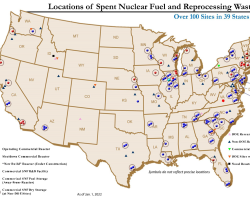Category of Content
Siting Experience Documents Only
Publication Date
Subject Matter
Keywords
Spent Nuclear Fuel and High-Level Radioactive Waste Inventory Report
Spent Nuclear Fuel and High-Level Radioactive Waste Inventory Report
Nuclear Fuels Storage and Transportation Planning Project Inventory Basis?, Rev 1
Nuclear Fuels Storage and Transportation Planning Project Inventory Basis?, Rev 1
Dry Storage Cask Inventory Assessment
Dry Storage Cask Inventory Assessment
The Morally Desirable Option for Nuclear Power Production
The Morally Desirable Option for Nuclear Power Production
This paper reflects on the various possible nuclear power production methods from an ethical perspective. The production and consumption of nuclear power give rise to the problem of intergenerational justice; in other words, we are depleting a nonrenewable resource in the form of uranium while the radiotoxic waste that is generated carries very long-term potential burdens. I argue that the morally desirable option should therefore be to seek to safeguard the interests of future generations.
Reset of America's Nuclear Waste Management Strategy and Policy
Reset of America's Nuclear Waste Management Strategy and Policy
The U.S. nuclear waste management program has labored for decades at a cost of billions of dollars each year, and yet there is still no active disposal program either for spent nuclear fuel from commercial reactors or for the high-level radioactive legacy waste and spent nuclear fuel from defense programs.
U.S. Nuclear Plant Shutdowns, State Interventions, and Policy Concerns
U.S. Nuclear Plant Shutdowns, State Interventions, and Policy Concerns
The United States has the largest nuclear power plant fleet in the world, with 93 reactors that can generate approximately 95,522 megawatts (MW) of electricity. Nuclear power has accounted for about 20% of annual U.S. electricity generation since the late 1980s; in 2020 it was 19.7%. However, the U.S. nuclear power industry in recent years has been facing economic and financial challenges, particularly plants located in competitive power markets where natural gas and renewable power generators influence wholesale electricity prices. Twelve U.S.
Interim Storage, Environmental Justice, and Generational Equity
Interim Storage, Environmental Justice, and Generational Equity
With the termination of the Yucca Mountain project, which was proposed to be our nation’s first repository for the disposal of military and civilian spent nuclear fuel and high-level radioactive waste, the future of nuclear waste management and disposal in this country became increasingly uncertain. Interim storage has been advocated by many as a temporary solution while a permanent solution is studied for potentially several more decades to come.
Transportation Planning: Indigenous Dialogue
Transportation Planning: Indigenous Dialogue
In 2019, the NWMO commissioned Maawandoon Inc to lead Indigenous Dialogue session to support NWMO’s transportation planning for the long-term care of Canada’s used nuclear fuel. This research built upon and complemented public attitude research carried out in 2017 and 2018. The research methodology consisted of 7 Indigenous dialogue sessions and attendance at 3 Indigenous Annual General Assemblies (AGA)/meetings with dialogue components.
Survey of National Programs for Managing High-Level Radioactive Waste and Spent Nuclear Fuel: 2022 Update
Survey of National Programs for Managing High-Level Radioactive Waste and Spent Nuclear Fuel: 2022 Update
In October 2009, the U.S. Nuclear Waste Technical Review Board (Board or NWTRB) published Survey of National Programs for Managing High-Level Radioactive Waste and Spent Nuclear Fuel. For each of the 13 national programs studied, the report catalogued 15 institutional arrangements that had been set in place and 15 technical approaches that had been taken to design repository systems for the long-term management of high-activity radioactive waste.
Spent Nuclear Fuel and Reprocessing Waste Inventory, Revision 9
Spent Nuclear Fuel and Reprocessing Waste Inventory, Revision 9
This report provides information on the inventory of spent nuclear fuel (SNF) in the United States located at Nuclear Power Reactor and Independent Spent Fuel Storage Installation sites, as well as SNF and reprocessing waste located at U.S. Department of Energy sites and other research and development centers as of the end of calendar year 2021.
Status and Trends in Spent Fuel and Radioactive Waste Management
Status and Trends in Spent Fuel and Radioactive Waste Management
Status and Trends in Spent Fuel and Radioactive Waste Management is a collaborative project between the IAEA, the European Commission and the OECD Nuclear Energy Agency, with the participation of nuclear industry organization the World Nuclear Association, that aims to consolidate and complement the information gathered from different initiatives around the world.
Dry Storage Cask Inventory Assessment, Revision 2
Dry Storage Cask Inventory Assessment, Revision 2
The report, Commercial Spent Nuclear Fuel and High-Level Radioactive Waste Inventory Report(FCRDNFST- 2013-000263, Rev.4), provides information on the inventory of commercial spent fuel, referred to in this report as used nuclear fuel (UNF), as well as Government-owned UNF and High Level Waste (HLW) in the U.S. Department of Energy (DOE) complex. Inventory forecasts for commercial UNF were made for a few selected scenarios of future commercial nuclear power generation involving the existing reactor fleet including one scenario involving reactors under construction.




